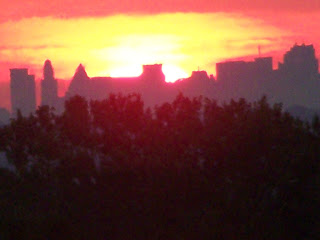The Sun By Day
 Loving astronomy means more than just the moon and the lunar eclipses, of which I have seen many over my 39 years of living. But there is the magic and majesty of the sun, which gives us life in rich abundance, deserts, jungles, etc. The sun that gives life to everything, all that we are and have. I love the sun, too - and not in a how-much-pigmentation-can-I-add way, either. I can't anyway - I'm Irish, but I have sallow skin that fries and then returns to its natural yellow-white state...
Loving astronomy means more than just the moon and the lunar eclipses, of which I have seen many over my 39 years of living. But there is the magic and majesty of the sun, which gives us life in rich abundance, deserts, jungles, etc. The sun that gives life to everything, all that we are and have. I love the sun, too - and not in a how-much-pigmentation-can-I-add way, either. I can't anyway - I'm Irish, but I have sallow skin that fries and then returns to its natural yellow-white state...The sun rising over the New York City skyline seen from the fourth tee of the Upper Course. This was taken on Tuesday, 28 August, at approximately 0625.
I have an incredible telescope that lets me view the sun as much as the moon and the stars at night. I have a big incredibly dark filter made for solar viewing. I had it in time for the transit of Venus across the morning sun in June of 2004. It was AMAZING. My intent is to also see it transit again in 2012. I'm hoping the gods are as good to me on this as they were the first time.
I may have missed the lunar eclipse yesterday morning, but John mentioned the sunrise looking incredible from the fourth tee. So I took the cart up there and wow. Wait until you see these images!
I have had the intense and indescribable experience of one solar eclipse in my lifetime, in 1979. The sun was ecipsed in the middle of the day and the sight was unreal. Truly a beautiful thing to see. It was a million years ago, but I remember it so well. I also experienced a partial solar eclipse in 2002, and while it was no where near as spectacular as the full deal, it was... very strange. The air quality was very strange... I remember it clearly but it is hard to describe. Very hard to describe. It had a... sort of greyed out feel to it... I don't have the right words.
Some stats on Sol: Our Sun is a normal main-sequence G2 star, one of more than 100 billion stars in our galaxy. diameter: 1,390,000 km. mass: 1.989e30 kg temperature: 5800 K (surface) 15,600,000 K (core)
The Sun is by far the largest object in the solar system. It contains more than 99.8% of the total mass of the Solar System (Jupiter contains most of the rest).
It is often said that the Sun is an "ordinary" star. That's true in the sense that there are many others similar to it. But there are many more smaller stars than larger ones; the Sun is in the top 10% by mass. The median size of stars in our galaxy is probably less than half the mass of the Sun.
The Sun is personified in many mythologies: the Greeks called it Helios and the Romans called it Sol.
The Sun is, at present, about 70% hydrogen and 28% helium by mass everything else ("metals") amounts to less than 2%. This changes slowly over time as the Sun converts hydrogen to helium in its core.
The outer layers of the Sun exhibit differential rotation: at the equator the surface rotates once every 25.4 days; near the poles it's as much as 36 days. This odd behavior is due to the fact that the Sun is not a solid body like the Earth. Similar effects are seen in the gas planets. The differential rotation extends considerably down into the interior of the Sun but the core of the Sun rotates as a solid body.


Conditions at the Sun's core (approximately the inner 25% of its radius) are extreme. The temperature is 15.6 million Kelvin and the pressure is 250 billion atmospheres. At the center of the core the Sun's density is more than 150 times that of water.
The Sun's energy output (3.86e33 ergs/second or 386 billion billion megawatts) is produced by nuclear fusion reactions. Each second about 700,000,000 tons of hydrogen are converted to about 695,000,000 tons of helium and 5,000,000 tons (=3.86e33 ergs) of energy in the form of gamma rays. As it travels out toward the surface, the energy is continuously absorbed and re-emitted at lower and lower temperatures so that by the time it reaches the surface, it is primarily visible light. For the last 20% of the way to the surface the energy is carried more by convection than by radiation.
I did take this the same date as above about ten minutes later. It is magic!

Comments